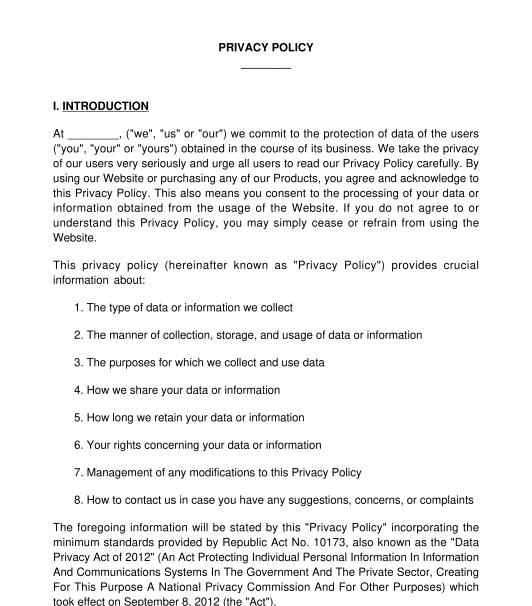 10/06/2025
10/06/2025

Answer a few questions and your document is created automatically.

Your document is ready! You will receive it in Word and PDF formats. You will be able to modify it.

 10/06/2025
10/06/2025
 Word and PDF
Word and PDF
 8 to 12 pages
8 to 12 pages
A Privacy Policy can be used by any person or organization in the Philippines that owns a website (also referred to as the Personal Information Controller or PIC) to lay down the manner by which the collection or handling of data or information of the website's users is done. These users are known as the "data subjects".
A website that collects and handles data or information (also known as personal information) should have this document to enable the users to know how their data or information is collected and processed.
While it is encouraged that both documents are used by the website and posted thereon, Terms and Conditions are different from a Privacy Policy. If the document requires the terms and conditions concerning the privacy rights of its users, this Privacy Policy should be used. On the other hand, if the document requires the terms and conditions concerning the general usage of the website, then Terms and Conditions for a Website should be used.
If the owner of a website processes or takes data from users and uses them to render services or sell products under a website then a Privacy Policy is mandatory. On the other hand, if the owner of the website does not take data from users (e.g. posting content only on the website such as articles without any interaction from the users), then a Privacy Policy is not mandatory.
Note that processing may mean any activity done to data or information pertaining to users such as collection, organization, usage, combination, deletion, etc.
Further, a Privacy Policy is necessary to set up the expectations for the user with respect to the data that they share on the website.
For the processing of Personal Information to be lawful, any of the following conditions must be complied with:
Other specific types of personal information are Sensitive Personal Information and Privileged Information, for which stricter rules apply due to the sensitive nature of the data. Sensitive Personal Information and Privileged Information can only be processed when this is justified i.e. with the consent of the user, if allowed by existing laws and regulations, if necessary for lawful, non-commercial objectives of certain organizations, if necessary for the user's medical treatment, and if necessary for legal claims or defense of lawful rights and interests of persons. The National Privacy Commission's website should be checked to determine in detail the conditions to validly process Sensitive and Privileged Information.
A Privacy Policy contains the following information:
The parties in this document are the owner of the website and the website user. The owner of the website is also called the "Personal Information Controller or PIC" who will lay down the manner by which the collection or handling of data or information of the website's users is done. The website users are also known as the "data subjects".
While it should be agreed upon by both parties, it usually cannot be changed by the user so that if the user uses the website, they agree to accept the Privacy Policy of the website. However, if they don't agree to the Privacy Policy, then they should not use the website.
After completing all the information required for the Privacy Policy, the owner of the website should review the same.
Once the document is complete and reviewed, it should be published on the website in order for the users of the website to have access to it. It should be posted on its own separate page on a website which is ideally linked and can be accessed from the home page under the phrase "Privacy Policy".
It is the choice of the website owner if he wants any of the following:
No costs or fees need to be paid for the Privacy Policy, as it only requires postage of the same to a web page in the Website itself.
This document is governed by the Provisions of R.A. 10173 or the Data Privacy Act of 2012 and its rules and regulations.
You fill out a form. The document is created before your eyes as you respond to the questions.
At the end, you receive it in Word and PDF formats. You can modify it and reuse it.
Privacy Policy for Website - sample template
Country: Philippines